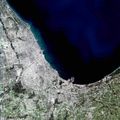This article has multiple issues. Please help improve it or discuss these issues on the talk page . (Learn how and when to remove these messages)
|
Lake in the Hills, IL | |
|---|---|
Village | |
 | |
 Location of Lake in the Hills in McHenry County, Illinois. | |
| Coordinates: 42°11′32″N88°20′51″W / 42.19222°N 88.34750°W [1] | |
| Country | United States |
| State | Illinois |
| County | McHenry |
| Township | Grafton, Algonquin |
| Incorporated | 1952 |
| Government | |
| • Type | Village President/Trustee |
| Area | |
• Total | 10.44 sq mi (27.03 km2) |
| • Land | 10.20 sq mi (26.43 km2) |
| • Water | 0.24 sq mi (0.61 km2) |
| Elevation | 814 ft (248 m) |
| Population (2020) | |
• Total | 28,982 |
| • Density | 2,840.5/sq mi (1,096.72/km2) |
| Time zone | UTC-6 (CST) |
| • Summer (DST) | UTC-5 (CDT) |
| ZIP code | 60156 |
| Area code(s) | 847 & 224 |
| FIPS code | 17-41183 |
| GNIS feature ID | 2398378 [1] |
| Website | www |
Lake in the Hills is a village in McHenry County, Illinois, United States. As of the 2020 census, the population was 28,982.
Contents
- History
- Geography
- Surrounding areas
- Demographics
- 2020 census
- 2010 Census
- Neighborhoods
- Education
- Elementary schools
- Middle schools
- High schools
- Community colleges
- Libraries
- Transportation
- Notable people
- References
- External links
The village is most known for its very high residential growth which occurred most heavily in the 1990s. Once a sleepy lakeside village of cottages and small ranches, its population skyrocketed as developers flocked to the area in the 1990s. Its population increased by 17,000 people (a nearly 400% increase) over this period, making it one of the most rapidly growing suburbs of Chicago and in the United States at that time. At the height of its building boom, the village issued over 1,000 residential building permits in 1995.[ citation needed ]




